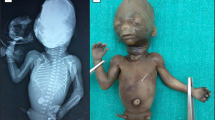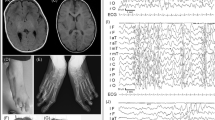Abstract
WHILE cases of autosomal trisomy of the D (Nos. 13–15) and the E (Nos. 16–18) group of human chromosomes apparently are not too uncommon, structural anomalies of these chromosomes, including cases of translocation, are, to our knowledge, still very infrequent1. During the past two years some cases of multiple congenital malformations showing an abnormal ring-shaped autosome have been published, in which one autosome of the chromosome group Nos. 13–15 (refs. 2 and 3) or of the group Nos. 16–18 (refs. 2, 4 and 5) is missing. Self-perpetuating ring chromosomes have also been described somewhat earlier as probably derived from the X chromosome6 and from an autosome (?) of the C group7. We wish to report the findings in a male child with multiple malformations, in whom a chromosomal study revealed an abnormal autosome combined with the lack of one of the group E chromosomes, probably a chromosome No. 18.
This is a preview of subscription content, access via your institution
Access options
Subscribe to this journal
Receive 51 print issues and online access
$199.00 per year
only $3.90 per issue
Buy this article
- Purchase on Springer Link
- Instant access to full article PDF
Prices may be subject to local taxes which are calculated during checkout
Similar content being viewed by others
References
Rohde, R. A., Lee, A., and Sapin, S., Lancet, ii, 1309 (1963).
Wang, H. Ch., Melnyk, J., McDonald, L. T., Uchida, I. A., Carr, D. H., and Goldberg, B., Nature, 195, 733 (1962).
Bain, A. D., and Gauld, I. K., Lancet, ii, 304 (1963).
Genest, P., Leclerc, R., and Auger, C., Lancet, i, 1426 (1963).
Lucas, M., Kemp, N. H., Ellis, J. R., and Marshall, R., Ann. Hum. Genet., 27, 189 (1963).
Lindsten, J., and Tillinger, K. G., Lancet, i, 593 (1962).
Turner, B., Jennings, A. N., Den Dulk, G. M., and Stapleton, Th., Med. J. Austral., 1, 56 (1962).
Frøland, A., Holst, G., and Terslev, E., Cytogenetics, 2, 99 (1963).
Edwards, J. H., Harnden, D. G., Cameron, H. S., Crosse, V. M., and Wolff, O. H., Lancet, i, 787 (1960).
Crawford, M. d'A., Lancet, ii, 22 (1961). See also, Wagshal-Ives, R., and Berman, J. L. (personal communication and Hum. Ch. Newsl. No. 11).
Author information
Authors and Affiliations
Rights and permissions
About this article
Cite this article
GROPP, A., JUSSEN, A. & OFTERINGER, K. Multiple Congenital Anomalies associated with a Partially Ring-shaped Chromosome probably derived from Chromosome No. 18 in Man. Nature 202, 829–830 (1964). https://doi.org/10.1038/202829a0
Issue Date:
DOI: https://doi.org/10.1038/202829a0
This article is cited by
-
A case of 46,XX,18p–/46,XX,r(18) mosaicism
Japanese journal of human genetics (1978)
-
Partial monosomies 18
Human Genetics (1972)
-
Ring-chromosom 18
Human Genetics (1972)
-
Ringchromosom Nr. 18 und fehlendes Ig A bei einem 6j�hrigen M�dchen (46,XX,18r)
Zeitschrift f�r Kinderheilkunde (1970)
-
Defizienz am langen Arm eines Chromosoms Nr. 18 (46, XX, 18 q-)
Zeitschrift f�r Kinderheilkunde (1967)
Comments
By submitting a comment you agree to abide by our Terms and Community Guidelines. If you find something abusive or that does not comply with our terms or guidelines please flag it as inappropriate.



